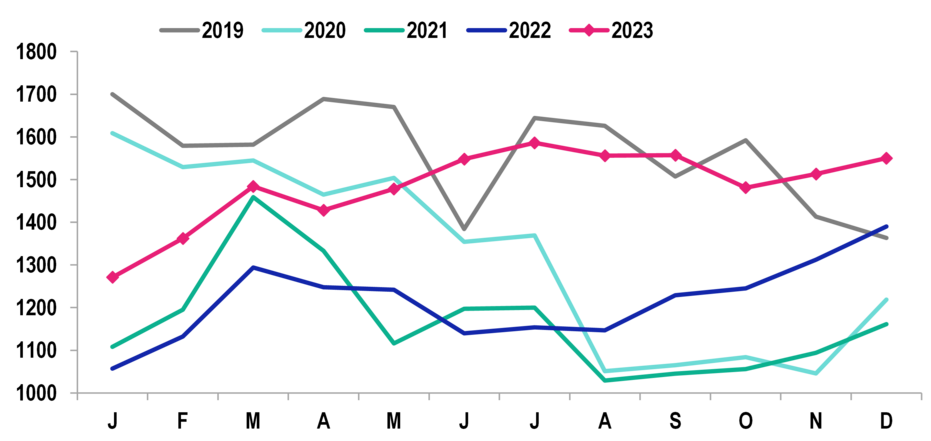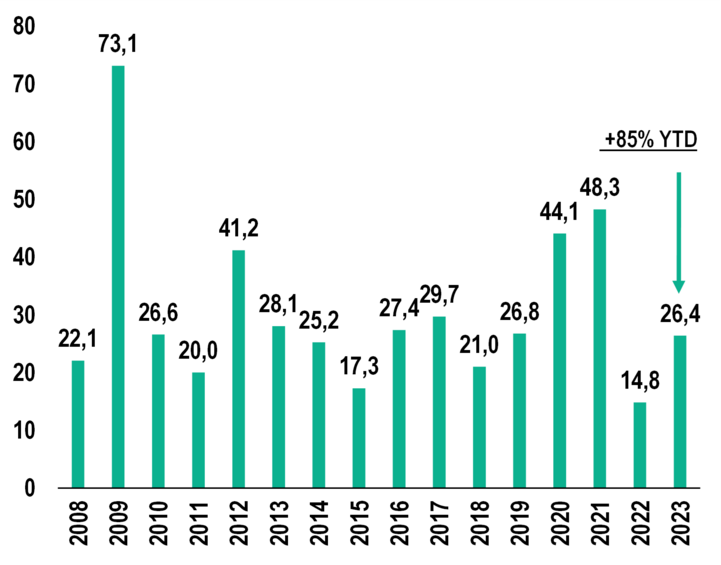According to the Federal Statistical Office, corporate insolvencies in Germany rose by 22.1% last year compared to the previous year. Despite this sharp increase, this is merely a normalization to pre-pandemic levels. With a total of 17,814 insolvencies, the figure for 2023 was still below the 2019 level, when 18,749 company bankruptcies were registered.
For a long time, it looked as if not much would change in the German corporate landscape. Well before the start of the coronavirus pandemic, the number of corporate insolvencies in Germany was falling steadily, reaching an all-time low in 2019. With the pandemic came various government support measures - combined with the suspension of the obligation to file for insolvency between spring 2020 and summer 2021. Insolvency figures reached new record lows and only began to rise again hesitantly when the government aid measures to combat the consequences of the pandemic expired in mid-2022. The year 2023 was therefore the first year since the start of the pandemic in which significantly fewer support measures were available - although the state also provided support at the start of the year in view of the high energy prices (Figure 1).
Figure 1: Number of corporate insolvencies in Germany per month
(Source: Destatis, Macrobond, Coface)



Wholesale and retail trade and construction with most bankruptcies
In view of the weak economic outlook in Germany, an increase in insolvencies had been expected. "As is the case every year, most insolvencies were in the construction, wholesale and retail sectors. These are the sectors in which most insolvencies traditionally take place, as most companies in Germany also belong to these sectors," says Christiane von Berg, Coface economist for Germany. "However, if you look at the insolvency ratio, i.e. the number of insolvencies per 10,000 companies, the transport and storage sector is right at the top with 106.5 insolvencies," says von Berg. Across all sectors in Germany, the rate was 52.5 insolvencies per 10,000 companies. The "other economic services" sector, which includes temporary employment agencies, for example, was also above average with 84.9 insolvencies, followed by the construction industry (79.9), the hospitality industry (72.3) and the manufacturing industry with 63.5 insolvencies per 10,000 companies.
138 insolvencies with receivables of more than 25 million Euros
Corporate insolvencies are associated with various risks, with the actual risk often being the expected claims arising from these insolvencies. These amounted to EUR 26.6 billion in 2023, which corresponds to an increase of 85% compared to 2022. The large jump in receivables is due to the fact that receivables were unusually low in 2022 (see chart 2). In 2023, the level of receivables was close to that of 2019. The discrepancy between the increase in the number of insolvencies and the level of claims is due to a higher number of major insolvencies. In 2023, there were a total of 138 insolvencies with claims of more than EUR 25 million, which corresponds to an increase of 38% compared to the previous year.
Figure 2: Expected claims from insolvencies in Germany, in EUR billion
(Source: Destatis, Coface)



A number of signs indicate that this increase in the number and scope of insolvencies is just the beginning. These include the applications for standard insolvency proceedings that are already known for January and February 2024. These proceedings apply to both companies and the self-employed and can be dismissed due to a lack of assets. Nevertheless, this indicator shows that a 22% year-on-year increase in insolvencies is possible at the beginning of the year alone. This would come as no surprise, as the economy in Germany has not been growing since the beginning of 2022 and companies are coming under increasing pressure. High wage demands - often over 10% year-on-year - or shorter working hours lead to high labor costs and, combined with increased financing costs, represent a considerable burden for companies. Taking all of these risk factors together, a further increase in corporate insolvencies to well over 19,000 companies is expected for 2024 as a whole.






